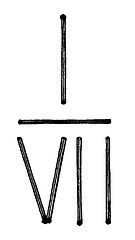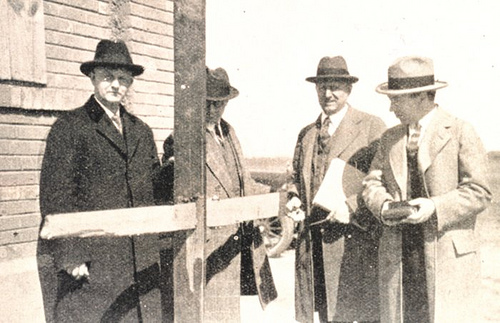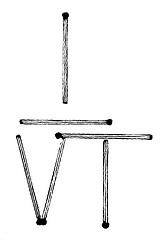“Everyone complains of his memory, and no one complains of his judgment.” — La Rochefoucauld
Right and Wrong
Brother Jacques Percher, “a very excellent man of the old time,” had a painting made for his chapel showing that good is the very opposite of evil. At one side was a picture of an angel, with the words “Read the right side and you will be saved.” Under that was this inscription:
Delicias fuge, ne frangaris crimine, verum
Coelica tu quaeras, ne male dispereas,
Respicias tua, non cujusvis quaerito gesta
Carpere, sed laudes, nec preme veridicos.
Judicio fore te praesentem conspice toto
Tempore, nec Christum, te rogo, despicias:
Salvificum pete, nec secteris daemonia; Christum
Dilige, nequaquam tu mala concupito.
Shun pleasures of the flesh, lest you be broken by crime; seek the things of heaven, lest your end be an evil one; consider your own deeds, and do not seek to slander someone else’s, but praise them, and do not suppress those who speak the truth; always realize that you must stand before a judgment; I beg you, do not despise Christ, seek him who gives salvation, and do not follow the devil; love Christ, and do not lust at all after evil.
At the other side was a picture of the devil with the words “Read the wrong side and you will be damned.” Here the first inscription was reversed word for word, producing an entirely different meaning:
Concupito mala tu, nequaquam dilige Christum,
Daemonia secteris, nec pete salvificum;
Despicias, rogo te, Christum, nec tempore toto
Conspice praesentem te fore judicio:
Veridicos preme, nec laudes, sed carpere gesta
Quaerito cujusvis, non tua respicias,
Dispereas male, nec quaeras tu coelica; verum
Crimine frangaris, ne fuge delicias.
Lust after evil, and do not at all love Christ; you follow the devil, do not seek him who gives salvation; despise Christ, I beg you, and realize that never will you stand before a judgment; suppress those who speak the truth, and do not praise the deeds of anyone, but seek to slander them; do not consider your own; let your end be an evil one, do not seek the things of heaven; let yourself be broken by crime, do not shun pleasures of the flesh.
“It must have taken the brother a long time to compose this,” writes George Wakeman, “but he probably did it with a holy purpose, and as a recreation from more onerous duties.”
See also A Bilingual Palindrome.
World’s Tidiest Epitaph

Cited in Epitaphiana: or, The Curiosities of Churchyard Literature, 1873.
Trade Relations
Northland and Southland were happy neighbors until yesterday, when Northland declared that a Southland dollar was to be worth only 90 Northland cents.
Not to be outdone, Southland declared that a Northland dollar would be worth 90 Southland cents.
I live in Centerville, on the border between the two countries. I go into a Northland store and buy a kazoo, which costs 10 cents. I pay for it with a Northland dollar and receive a Southland dollar as change.
Then I go across the street and enter a Southland store. There I buy a lemon, which also costs 10 cents. I pay for it with a Southland dollar and receive a Northland dollar as change.
When I get home I have my kazoo and lemon, for which it appears I’ve paid nothing. And each of the merchants has an additional 10 cents in his receipts.
So who paid for the kazoo and the lemon?
(From Eugene Northrop.)
Strange Newspapers
Between 1834 and 1874, proud New Englander James Johns published the Vermont Autograph and Remarker, an irregular collection of history, essays, verse, and fiction. It was irregular because Johns wrote each issue in pen, in a beautifully lucid newspaper font with no erasures. Johns bought a small hand press in 1857 but rarely used it — he found he was actually faster with the quill.
In January 1890, a tremendous blizzard struck the Sierra Nevada, paralyzing a Southern Pacific Railroad train and trapping its 600 passengers in their cars for three weeks. On Jan. 31 one of them, George T. McCully, began publishing a newspaper, the Snowbound, “issued every week-day afternoon by S. P. Prisoner in Car No. 36, blockaded at Reno, Nevada.” We know that McCully offered to sell copies of the hand-penciled four-page daily for 25 cents each; it’s not clear whether he got past the first issue. Perhaps he ran out of paper.
In a Word
xenium
n. a gift given to a guest
“An Ingenious Match Puzzle”
From Henry Dudeney:

“Place six matches as shown, and then shift one match without touching the others so that the new arrangement shall represent an arithmetical fraction equal to 1. The match forming the horizontal fraction bar must not be the one moved.”
Footwork
This walking hero [Daniel Crisp] on Sept. 21, 1802, walked one mile in seven minutes and fifty seconds, on the City-road, London.—July 16, 1817, commenced walking backwards forty miles daily for seven days, and completed 280 miles by that retrograde motion, on Wormwood Scrubs, near London, one hour and a quarter within the given time, to the surprise of thousands who witnessed the performance. … April 23, 1818, commenced walking from London to Oxford, to and fro by way of Datchet, Windsor, and Henley, the distance of sixty-one miles daily for seventeen successive days, and completed the 1037 miles on the 9th of May at eight minutes after eleven at night, being fifty-two minutes within the given time; during the performance of this arduous undertaking it rained heavily for ten days, which caused the Thames to overflow on the road to the depth of two feet and a half, and a quarter of a mile in length, which he was obliged to walk through for five days.
— Pierce Egan, Sporting Anecdotes, Original and Selected, 1822
Mean Winds

The Tri-State Tornado of 1925 traveled 200 miles through the American Midwest, killing nearly 700 people.
Along the way, it drove a 1×5-inch board through a 2×6-inch plank.
The Chair Trick
If you’re a woman and want to humiliate a man, invite him to watch you do this:
- Stand with your toes touching a wall.
- Placing one foot immediately behind the other, take two steps back.
- Have him place a chair between you and the wall.
- Bend at the waist and place the top of your head against the wall.
- Lift the chair.
- Stand erect.
Now challenge him to do the same. If he’s like most men he’ll get stuck on step 6. The common explanation is that men’s hips are built differently; they also have proportionally bigger feet. Either way, you can easily pick his pocket while he’s struggling there.

